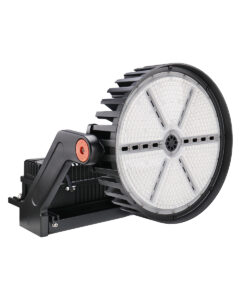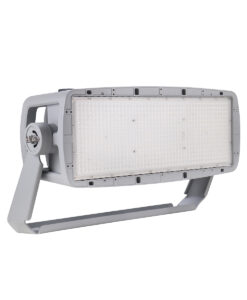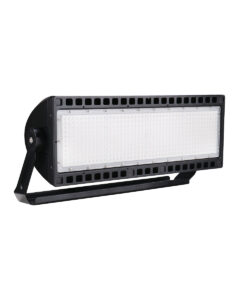Baseball field lighting requirements are crucial for player performance, safety, and spectator enjoyment. At PacLights, we understand the complexities of illuminating these expansive outdoor spaces effectively.
In this guide, we’ll break down the essential lighting specifications for different areas of the field and explore the best technology options available today.
What Makes Baseball Field Lighting Effective?
Illuminance: The Foundation of Visibility
Illuminance determines how much light falls on the playing surface. It’s measured in lux or foot-candles, with one foot-candle being approximately equivalent to 10.764 lux. High school baseball fields typically require 300 to 500 lux across the field. Professional fields demand much higher levels – up to 1,500 lux for the infield and 1,000 lux for the outfield. These higher levels allow players to track fast-moving balls with precision.
Uniformity: Eliminating Dark Spots
Uniform lighting prevents shadowy areas that compromise player safety and performance. The ideal max/min ratio is 2:1 for infields and 2.5:1 for outfields. This means the brightest spot on the field should be no more than twice as bright as the darkest spot in the infield (and no more than 2.5 times as bright in the outfield). Strategic placement of multiple light fixtures often achieves this uniformity.
Glare Control: Enhancing Visual Comfort
Glare can impair a player’s ability to track the ball, especially for outfielders facing directly into the lights. Fixtures with precise beam control mitigate this issue. Positioning lights at heights exceeding 28 meters for high school fields (and even higher for professional stadiums) ensures optimal viewing angles and minimal glare.
Standards and Guidelines
The American National Standards Institute (ANSI) provides guidelines for these metrics, which vary based on the level of play. A recreational field might require only 200 lux, while a televised professional game could demand up to 2,000 lux for optimal broadcast quality.
Tailoring to Specific Needs
Every baseball field has unique lighting requirements. A high school field hosting evening games twice a week needs different lighting than a professional stadium with frequent night games and TV broadcasts. The lighting design must account for these specific needs to provide the best possible environment for players and spectators alike.

As we move forward, let’s explore how these lighting principles apply to different areas of the baseball field, from the infield to the outfield and beyond.
How to Light Different Areas of a Baseball Field
Infield Illumination: The Heart of the Action
The infield requires the highest light levels on the field. High light levels and low glare are essential for professional games. This intense illumination allows players to track fast-moving balls and make split-second decisions.

High school fields function well with 300 to 500 lux, but higher levels improve play quality. The key is to maintain a uniformity ratio of 2:1 or better (the brightest spot should be no more than twice as bright as the darkest area).
To achieve this, a combination of high-output LED floodlights mounted on poles at least 28 meters tall works best. The exact number and placement of fixtures depend on the field’s specific dimensions and layout.
Outfield Lighting: Balancing Visibility and Glare Control
Outfield lighting presents unique challenges. While lower light levels are acceptable compared to the infield (1,000 lux for professional fields, 200-300 lux for high schools), uniformity becomes even more critical.
A uniformity ratio of 2.5:1 or better in the outfield prevents dark spots where fly balls might disappear from view. Careful aiming of fixtures minimizes glare for outfielders facing the lights.
One effective strategy uses asymmetrical fixtures that direct more light towards the infield, reducing backlight and spill into surrounding areas. This approach improves player visibility and minimizes light pollution.
Dugouts and Bullpens: Player Preparation Areas
Dugouts require 200-300 lux to ensure players can see clearly without creating a stark contrast to the field. Shielded fixtures prevent glare for players entering or exiting.
Pitchers need consistent lighting to warm up effectively in bullpens. Light levels similar to the main mound (around 1,000-1,500 lux for professional fields) work best.
Spectator Areas: Safety and Comfort
Safety is paramount in the stands. A minimum of 10-20 lux allows for safe movement, with higher levels (50-100 lux) in concession and circulation areas. Careful fixture placement prevents light spill onto the field.
A comprehensive lighting plan for a baseball field must consider how these different areas interact. A well-designed system creates a seamless visual experience for players and fans alike, enhancing the overall quality of the game.
Now that we understand the specific lighting needs for different areas of a baseball field, let’s explore the technology options available to meet these requirements effectively and efficiently.
Which Lighting Technology Is Best for Baseball Fields?
The LED Revolution in Sports Lighting
LED technology has become the top choice for baseball field illumination. These fixtures offer superior performance and long-term value compared to traditional lighting options.
Advantages of LED Lighting
LED lights outshine traditional metal halide lamps in almost every aspect. They provide instant-on capability, eliminating warm-up times and allowing for immediate full brightness. This feature proves invaluable during emergency situations or sudden weather changes during games.

LEDs also offer precise optical control, which allows for better light distribution and reduced light spill. This means more light reaches the field where it’s needed, rather than wasting it on surrounding areas.
Energy Efficiency and Cost Savings
The energy efficiency of LED technology translates to significant cost savings. LED lighting requires significantly less maintenance compared to traditional lighting. Due to their longer lifespan, LED lights save money on replacement costs and reduce the need for frequent maintenance work.
Consider a baseball field that previously used twenty 1500-watt metal halide fixtures. Replacing these with LED equivalents could reduce the total wattage from 30,000 to about 12,000 – a 60% energy saving. Over a 10-year period, this could amount to tens of thousands of dollars in reduced electricity costs.
Durability in Outdoor Environments
Baseball field lights must withstand extreme weather conditions, from scorching heat to freezing cold (not to mention the occasional impact from a stray ball). LED fixtures excel in this area, with many models rated for 100,000 hours of operation or more. This translates to over 50 years of use if the lights operate for 4 hours every day.
The long lifespan of LEDs significantly reduces maintenance needs. While metal halide lamps typically require replacement every 3-5 years, LED fixtures can last 10-20 years or more. This saves on replacement costs and reduces the need for disruptive maintenance work during the baseball season.
Color Rendering and Visual Comfort
For televised games and high-level play, color rendering is essential. LED lights with a Color Rendering Index (CRI) of 90 or higher provide excellent visual clarity, making it easier for players to track the ball and for spectators to enjoy the game. This high CRI also ensures that colors appear vivid and true-to-life on broadcasts.
The ability to dim LED lights and adjust color temperature adds another layer of flexibility. Groundskeepers can lower light levels for maintenance work, or adjust the color temperature to create the perfect ambiance for different events held at the field.
Baseball field lighting requirements are complex but essential for creating a safe and enjoyable environment. Proper illumination enhances player performance, ensures safety, and improves the overall experience of America’s favorite pastime. Each area of the field demands specific lighting considerations to meet the unique challenges of the sport.

The shift towards LED technology has revolutionized baseball field lighting. These advanced fixtures offer superior energy efficiency, longer lifespans, and better light quality compared to traditional options. The initial investment in LED lighting pays off through reduced energy costs, lower maintenance needs, and improved performance over time.
Professional lighting design and installation are crucial for achieving optimal results. At PacLights, we understand the intricacies of sports lighting (our range of LED fixtures and lighting control systems are designed to meet the demanding requirements of baseball fields at all levels). We offer tailored solutions that prioritize performance, efficiency, and longevity for high school diamonds and professional stadiums alike.





Disclaimer: PacLights is not responsible for any actions taken based on the suggestions and information provided in this article, and readers should consult local building and electrical codes for proper guidance.